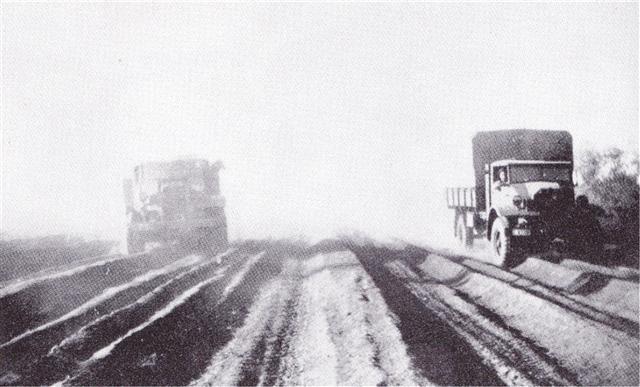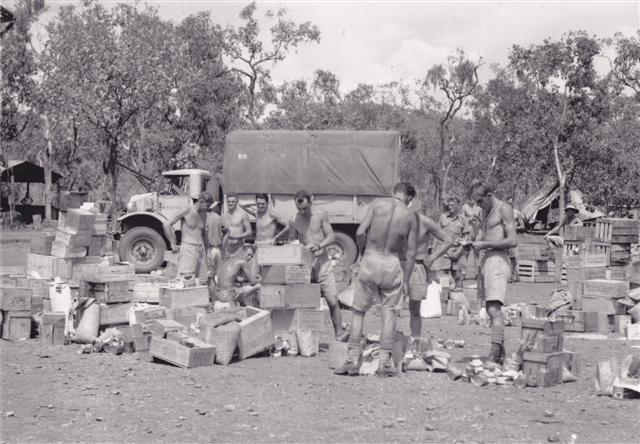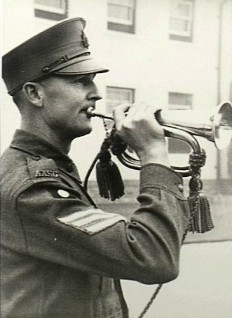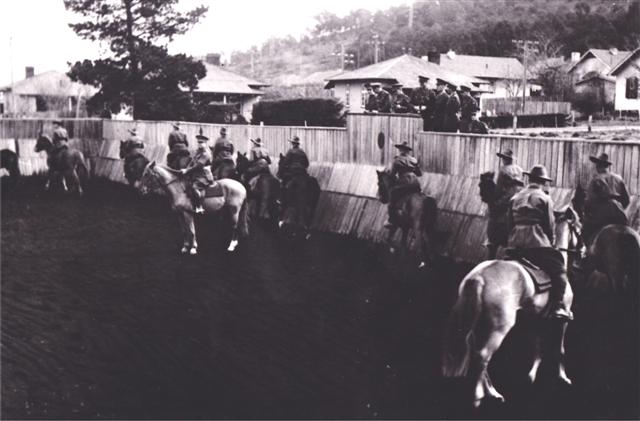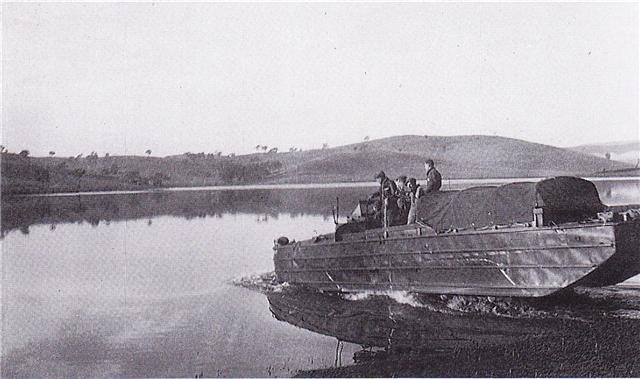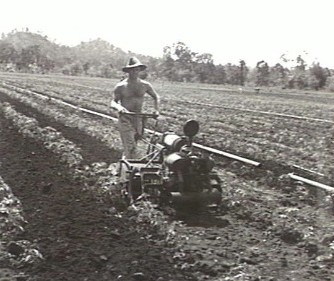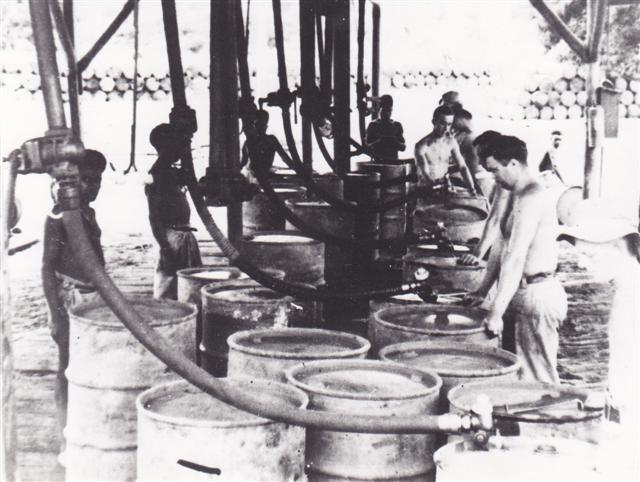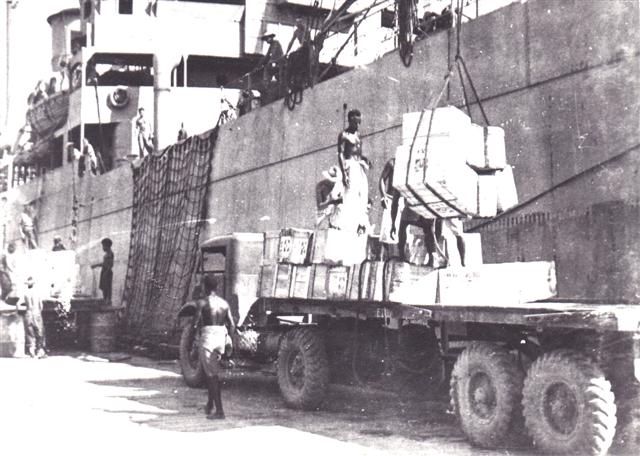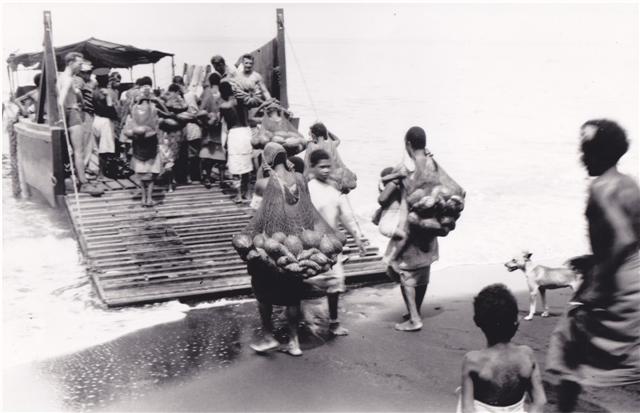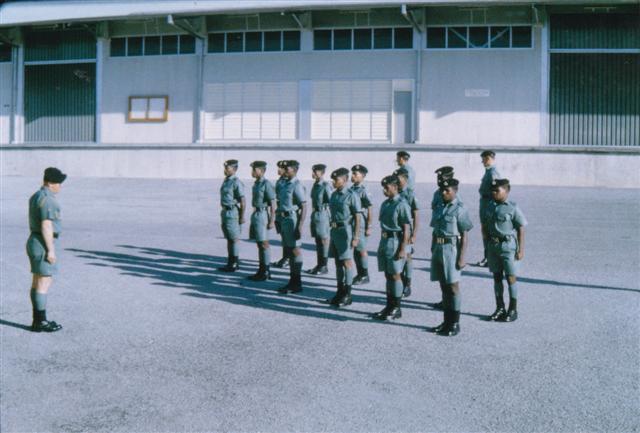Chapter 12
The Corps in the Territories
Northern Territory
Military forces returned to the Northern Territory, after the 19th century abandonment of the stations at Melville Island and the Coburg Peninsula, as a result of the 1932 decision to establish a naval station at Darwin and to fortify the port. As well as the Naval element and coastal artillery group, Darwin Mobile Force was an earmarked garrison of a mixed artillery and infantry group of 230, all nominally artillerymen to circumvent the Defence Act's embargo on regular infantry, constituted in 1938 and dispatched to Darwin in March 1939. An AASC element of a section of 4 Sup Pers Coy was also located in Darwin to support the buildup in the area, drawing rations in bulk from the Navy victualling stores and issuing them to units' transport. Officer Commanding Lieut W.J. Brady also filled the position of DADST on the Area Headquarters established in Darwin also in March 1939. AASC transport was not provided until the build up was begun in the following year, at which time ex-DST Col W.A.B. Steele was Commandant of 7 MD 1.
By the entry of Japan into the war in December 1941, 23rd Brigade of 8th Division had become the basis of the garrison. HQ 23 Bde AASC, 23 Bde Coy, 23 Bde Sec Amn Coy and C Sub-Sec 8 Div Amn Sub-Park were established at Noonamah; detachments of these units had by this time been hived off to the battalion group Sparrow, Gull and Lark Forces in Timor, Ambon and Rabaul. The infrastructure support for 7 MD had now grown to HQ AASC 7 MD with under command 7 MD AASC Coy and 124 Res MT Coy; based at Adelaide River were 7 MAC, 11 Sup Pers Coy, 12 Fd Bky, 3 Fd Bch Coy,1 BIPOD and 1 Farm Coy. The supply units had detachments located to serve the troop concentrations in the Vesteys, Katherine, Noonamah and Koolpinyah areas. And as the Japanese successes attracted increased air and land force concentrations to the Darwin area, NT Force replaced 7 MD and the garrison grew to 12th Division, which included HQ Comd 12 Div AASC, 2/3, 7 and 2/8 Coys, and 2/107 and 126 Aust GT Coys which absorbed the previous units. With the major increases in ground, air and naval combat units came the need for expanded lines of communication supplies and transport effort 2.
Pre-war, DST Colonel R.T.A. McDonald was convinced that the sea lines of support favoured and provided by Navy would not be viable under a threat from the north, and argued for the establishment of an overland supply route from Alice Springs railhead to Darwin, then no more than a bush track of 621 miles to Larrimah railhead. Preliminary arrangements were made with state road authorities for road construction and the growing uncertainty on Japan's position saw this contingency plan invoked in July 1940 3. As a result Darwin Overland Maintenance Force began establishing itself on the banks of the Todd River at Alice Springs on 8 September 1940, launched its pioneering convoy at 0430 hours the following day, literally following the Overland Telegraph Line. The initial force comprised a headquarters commanded by Lieut-Col N.M. Loutit DSO, 2/110 Tpt Coy and 14 Sup Pers Coy. The transport company had 14 officers and 606 soldiers operating 150 3 ton Chevrolet task vehicles along the North-South Road over four stages to Barrow Creek, Banka Banka, Elliot then Larrimah rail terminal. The supply unit set up detail issue depots at Alice Springs and each of the staging points 4.
To upgrade the track to unsealed road standard, sections were allotted to the road authorities of Queensland, South Australia, New South Wales and Commonwealth Department of the Interior, later coming under control of the Allied Works Council. The initial upgrading to dry weather standard was completed in three months. Thereafter this was then maintained and progressively improved to all weather standard, and with the entry of Japan into the war and the large build up of forces around Darwin, a decision was made to seal the road to take the greatly increased traffic. Begun in July 1942, it was completed in January l944, long after the threat had subsided, but the sealing was little more than fixing the surface dust, and 20 mph speed limits were generally enforced. The introduction of International and Ford 7 ton semi-trailers from March 1941 and Mack-Lanova 10 ton trucks and 8 ton trailers from May 1944 provided a far more resource-efficient fleet as is demonstrated in Table 8. However this output was retarded severely by the restriction of the Macks to 4 ton loadings to reduce road damage, and by not supplying sufficient 8 ton trailers, both very much against the advice of Loutit, Ieaving the balance to tow 3 ton trailers or nothing, so curtailing over half the Macks from a potential 18 ton payload to seven tons or less, while the rest ran at 11 tons. The tonnage/road maintenance cost tradeoff was not explored.
Even after the threat of invasion had passed, the Northern Territory for the AASC did not become a sleepy backwater. Life on The Track – the earlier memory did not give way to the later official Stuart Highway – was a continuing hard slog with an 11 day cycle:
Day 1 loading
Days 2 to 9 driving up and back
Day 10 unloading and maintenance
Day 11 half infantry training, half rest
then the cycle began again, with base soldiers fed into the system for variety and to augment understrength transport platoons. The average convoy size was 30 vehicles with two drivers per vehicle, a convoy commander in a light vehicle and a repair vehicle bringing up the rear. About one convoy in eight carried perishables which were covered with hessian sacking and hosed down at stopping points, using the Coolgardie Safe method of cooling; these moved at 25 mph with route priority on a two day and night run direct to Adelaide River. Forward loads comprised rations, fuel and lubricants, and ammunition; ordnance, signals, medical, aircraft and engineer stores; and troops moving forward. Returning convoys carried empty 44 gallon drums, returning troops, salvage, empty convoy vehicles 3 ton and under, and firewood for the staging posts.
[slideshow] Operations on The Track
A supplementary route also operated from railhead at Mt Isa across the Barkly Tableland through Camooweal, 6a Bore staging camp, to the Sturt Highway 30 miles north of Tennant creek and then following The Track to Larrimah; to reduce unnecessary running, arrangements were made to tranship loads to Alice-based vehicles at the road junction where only a few trucks were involved. This haul involved an extra half day, giving a 12 day cycle which, given the even more primitive conditions and unsealed east-west road, made for an even harder life than for the Alice-based companies.
Units involved in the operation for all or part of the period were:
Alice Springs Mt Isa
HQ DOMF (then Comd CA Tpt Coln, then 8 then 11 L of C Sub Area)
2/108,2/110, 117, 119, 121, 122, 126, 2/107, 2/108, 2/109, 134 GT Coys
140, 2/142, 146, 147, 148, 149 GT Coys 10 Sup Pers Coy (then BSD Mt Isa, then
14 Sup Pers Coy, 9 Adv Sup Dep (then 10 Sup Dep Coy and 71 Sup Dep Pl)
BSD Alice Springs, then 9 Sup Dep Coy 4 Fd Bch Pl
and 64-70 Sup Dep Pls) 2/1Wksp Pl
11 L of C Area BIPOD
14 Fd Bky
1, 2 Farm Coys
As improvements to The Track and phasing in of heavy vehicles improved productivity, so the number of units decreased and tonnages carried increased. The rhythm and tempo however did not falter: the controlling headquarters, expanded to Central Australia Sub-Area, then 11th Line of Communications Sub-Area, remained under command of now Brigadier Loutit, combining continuity, drive and spartan improvements to conditions with advances in roadway and equipment to increase output right to the end. The other factor was the men who operated and supported the system under gruelling conditions year after year – not a limited operation but the hardest one of all: a long, grinding haul without an obvious end. This was by no means a glamorous task in an operational area which most soldiers sought, but it was nevertheless an important part first in the defence of Australia under threat of invasion, then supporting offensive operations to the islands and sea to the north. It was an early model of line haul techniques which latter day transport officers failed to recognise, much less improve on, even well into the RACT period.
The garrison, depots and airfields around the Darwin area were the reason for the operation, and these required other AASC units for their direct and general support. After the reorganisation to the brick system the divisional supply, petrol and ammunition units became 2/3, 7 and 8 Coys, the latter replaced by 14 Coy in January 1943. There had been some augmentation of general support and base units, and some had changed titles with the renaming of 7 MD to NT (then 14) L of C Area. The main AASC concentrations remained at Adelaide River – 140 GT Coy, replaced by 118, 134 and 135 GT Coys which were supplemented by 117 and 122 GT Coys surplus from The Track in 1944; 1 MAC which replaced 7 MAC in providing ambulance detachments in areas of troop concentration; 7 (then NT L of C Area) BIPOD, replaced by 1 and 4 BIPODs, for distribution of fuels and lubricants, resupplied largely from 3 BuIk Petroleum Storage Coy in Darwin, with 1 Mob Oil Recycling Unit as their salvage arm; BSD Adelaide River and BSD Larrimah held and issued bulk rations and expense supplies to the sections of 11 Sup Pers Coy located in the areas of troop concentration, which distributed in detail to units – they were restructured as 11 and 12 Sup Dep Coys commanding 69-80 Sup Dep Pls. The supplies units were supplied with bread by 12 Fd Bky, then 5 and 14 Fd Bking Coys, and meat by 3 Fd Bch Coy plus a section of 8 Fd Bch Coy, which slaughtered local stock at the Manbulloo Meatworks, saving an otherwise almost impossible task of transporting fresh meat up The Track 5.
The need to import other perishables was considerably reduced by 1 Farm Gp commanding 1 and 2 Farm Coys and 1 Experimental Farm Pl. 1 Farm Coy produced vegetables, fruit, poultry, eggs, honey and pigs on farms at Adelaide River, Hayes Creek, Katherine and Coomallie Creek, reaching peak production on 300 acres in 1944 with 1,653 tons of fruit and vegetables, and in 1945 of 57,200 dozen eggs, 5,674lb of poultry and 2,129lb of honey. 2 Farm Coy served a similar function for Alice Springs and the staging areas, with farms at Alice, Spinifex, Wyecliffe Wells and Elliot and a wood collection depot at Dunmarra, while 1 Experimental Farm Pl conducted pioneering work on agriculture in the Territory, opening paths for the Farm Companies and later commercial operations. All the units in the Territory were commanded by HQ Comd 14 L of C Area AASC, which was controlled by the DDST staff of NT Force Headquarters 6.
[slideshow] Farm Operations
The conclusion of the war saw acceleration of the rundown of the forces, the residual Army elements after 1946 comprising small area detachments at Darwin's Larrakeyah Barracks supported by 107 Sup Dep Pl and 107 Tpt Pl, with a reconstituted Headquarters 7 Military District, converted to Northern Territory Command in 1950. The units were amalgamated into 107 ST Pl in 1955, the DADST doubling as OC: this situation remained until disbandment of the RAASC in 1973, when the unit was amalgamated into Headquarters Company of HQ 7 MD 7.
But even the smallest elements of the Corps participated in the final conversion ceremonies on its disbandment. A parade was held at Larrakeyah Barracks on 9 June 1973, Brig K.R. Colwill CBE Deputy Chief of Logistics Army Headquarters officiating. The Corps role in the Territory had been comparatively short and, except for the wartime segment, low key. But that period from 1940 to 1945 had provided a test in adverse conditions which was met and overcome, setting a standard of endurance and performance as an example for the future, as the area has once again began to be recognised as a gateway to Australia.
Australian Capital Territory
The presence of RAASC in the Capital Territory centred on four tasks at the Royal Military College Duntroon: the provision of supplies and transport to the College, operating a remount sub-depot, training of all staff cadets in mechanical transport, and special to corps training of those staff cadets allotted to the Corps, although not all these occurred simultaneously. The first function had been provided from its inception in 1910 by the Quartermaster staff purchasing by local contract under the auspices of the supply and Transport Staff of 2nd Military District in Sydney; also the Chief Clerk Mr W.J. Knights, who was commissioned in 1915, was appointed Transport Officer after the College purchased a Thornycroft lorry capable of carrying '45 cadets or 3 tons' in 1916. Knights moved to the Reserve of Officers in 1923 but continued as transport officer until both he and the transport disappeared in the move to Victoria Barracks Sydney in 1931. The Quartermaster assumed all supplies and transport functions, assisted by 2 MD's MT, Supply and Remount Sections, and continued to do so after the return to Duntroon in 1937, now with expanding AASC supplies and transport staffs which reached 75 by 1940. But the expansion of RMC's wartime endeavours to include short officer cadet courses and the Command and Staff School, and the introduction of mechanical transport training on the syllabus, finally put the workload beyond the gifted amateur level and a position of Transport Officer was finally established when Lieut F.R. Leaper arrived at the end of 1942 8. Thereafter a succession of officers filled the position of Supplies and Transport Officer, including Captains L.C. Chambers, J.J. Spring, R.R. Harding, L.J. Howarth, N.J. McGuire and L.P. Tonagh who provided the service through a small supply detachment and by being responsible for, if not actually controlling the unit transport pool.
Equitation training was a major subject. Horses for this training were initially managed by civilian grooms, but in 1924 the Inspector General of the Army took time in his annual report on the Army at large to recommend their replacement with Remount Section members, an unusual move against his recognition later in the report that the limitation of army members available was already severely hampering effective horse management in the existing Remount Sections. Nothing came of this until after the move to Sydney in 1931 where 2 MD Remount Section took over the function, and continued to provide a detachment of 13 after the return to Duntroon. This arrangement continued to the end of the equitation era 9.
Mechanical transport at RMC was initially a haphazard affair. There were from early days one or more trucks and motor cars, initially for administrative use and then additionally doubling as gun tractors with two RAE NCO drivers on the staff. These positions were converted to AASC in 1932 as part of the rationalisation of Permanent drivers, growing to four staff sergeant instructors and 32 drivers by the beginning of the war. But the total absence of mechanical training was noted by early graduate and aircraft pioneer L.J. Wackett in 1913, though this is hardly surprising in an army so dedicated to the horse as the means of terrestrial mobility that the only ground mechanised unit was the Army Flying Corps. Mechanical training was introduced as an optional subject at the College in the 1920s, but received no real acceptance until a belated attempt in mid-1939, using borrowed Department of Interior vehicles, and their drivers from the Commonwealth car pool, as instructors. The College request to the Department that 'the older and more varied the vehicles the better' recognised just what the Army had in store when it came to hiring and requisitioning its vehicle requirements on mobilisation.
This training continued into the next year using borrowed vehicles and bren gun carriers until, in the rash of enthusiasm for armoured units as the cavalry was phased out, some light tanks were allocated to the College and the larger picture of general purpose transport was squeezed by concentrating training on tank driving, conducted by AASC assistant instructors. Reality returned a year later after operations switched to the Pacific, armoured divisions were no longer the flavour of the month and basic vehicle training returned 10, but the sequence had been a very obvious example of the faddism to which the Australian Army has always been susceptible, and one which tended to leave it prepared to fight the last rather than future campaigns. However the era of the horse soldier, and the tradition of officers being either mounted or of the equestrian class, died hard. Equitation and Cavalry Training was reintroduced in 1945 under the guise of the character-building curriculum, and fox hunts held, perhaps this latter was in the misapprehension that it also built officer qualities, but commonsense won with the final termination of equitation the following year. From then on all staff cadets received a period of basic driving and maintenance training, with some additional specialised work during corps training on carriers and armoured vehicles as appropriate to corps 11. The basic training was conducted by the RAASC officer on the instructional staff, using the combined resources of the College assistant RAASC instructors, its motor transport section, and vehicles and instructors loaned from Eastern Command for a crash practical course to complement theoretical training.
Special to Corps training for the graduating class was introduced in 1913, lapsed during the war, and started again in 1920, but with the first AASC allotment waiting until J.A. Durragh in 1927. It was not until 1940 that the Corps received a temporary windfall in the shape of the cavalry specialists, who perforce had to graduate into AASC as the only then avenue to the tanks; one stayed in AASC eventually to become Director, others found their way back to the Armoured and other Corps via the AIF. Corps training ceased during the short courses of World War 2, to be reintroduced in 1950. Initiated for AASC allottees by Capts L.C. Chambers and J.J. Spring, this encompassed advanced driving, including from 1955 training with DUKW amphibians, and a general introduction to RAASC, its responsibilities and operations. A significant upgrade in this training was effected by RAASC instructor Maj I.H. Hayman, who determined to pack as much theoretical and practical work as possible into the syllabus to ease the way of graduates, whose only corps training in the year immediately after commissioning was a short transport course. The amphibian training was to have a grim practical use the following year in the College sailing club, tragedy on Lake George, when the DUKWs were used in recovery of those drowned, Staff Cadet D.W. Ford receiving the George Medal for his effort in the initial lifesaving attempts. Shortly after this in 1960 all corps training was discontinued in favour of postgraduate courses at corps schools to make space for additional academic work in the planned degree course. However a six month course at the RAASC Centre for graduates allotted to RAASC after four years at the College was hardly a boon when they expected and wished nothing more than to get on with practical soldiering 12. As a consequence of this change, later RAASC instructors at the College Majs N.G. Hansen and B.R. Fegan were not required for Corps instruction, but occupied the position of company commanders of the corps of staff cadets, a function carried out by previous RAASC instructors as a sideline.
There was a delayed but inevitable augmentation to the RAASC element in Canberra in 1962. It was Government policy to move Federal departments to the national capital progressively as accommodation was built, the Staff branches of Army Headquarters being the first to move from Melbourne in the late 1960s, followed by the supporting services directorates. The Directorate of Supplies and Transport was reunited with the Quartermaster General Branch in a mausoleum known as the Administration Building which was shared with Department of Foreign Affairs. These moves were the beginning of a captivity in Egypt for an increasingly large segment of the Armed Forces, which saw a growing number of servicemen matching a growing Defence bureaucracy in Canberra, away from the real function of soldiers, sailors and airmen. While there must undoubtedly always be a need for military policy and planning staffs, the Canberra environment both siphoned ever larger numbers to those tasks and taught many of them too well the habits of bureaucrats – that there are no apparent penalties for failure, that time is not of the essence, that compromise is the essence of success, and that to say so is to imagine it done. All these are anathema to the genuine soldier. The Canberra experience reduced drastically the proportion of genuine soldiers by providing a comfortable lifestyle in exchange for compromise of military leadership, austerity and goal achievement, although the worst effects of this were felt as a product of the Tange amalgamation and expansion of the Defence and Service Departments, after RAASC had left the scene.
Whatever the final result, the presence in Canberra was both inevitable and necessary, as was demonstrated, again later, in the post-Hassett reorganisation when the Directorate of Transport languished without proper influence in Logistic Command in Melbourne. In the 1962 reunion, as much as some members of DST resented returning to the direct tutelage of QMG Branch from the temporary separation and seclusion in Melbourne, the positive side was that an active director such as Brig V.E. Dowdy and the more able of his staff could more effectively communicate with and influence the General Staffs. Successive directors Durance, Richardson and Bunting exhibited craft, evenness and guile in their progression of the management of the Supplies and Transport Service and the RAASC. Some fair recovery had been made from the 1950s when, after the Director's position had been filled by a lieutenant colonel, then been upgraded progressively to colonel and brigadier once more under D.G. McKenzie, it had been found necessary to appoint an infantry officer in default of an acceptable RAASC officer. A stronger line of talent which later became available rectified this deficiency and also facilitated RAASC officers filling a wide range of appointments in scope and rank in the General Staff, Adjutant General and Quartermaster General Branches. Such appointments demonstrated an increasing depth of capacity which resulted in an increasing number of RAASC officers being selected for senior command and staff appointments in direct competition with officers of all arms. Every cloud has its silver lining.
Australian Antarctic Territories
RAASC's relationship to Australia's Antarctic Territory can be best classed as migratory. Its function was to provide the ship-to-shore discharge of vessels on detachment or charter to the Australian National Antarctic Research Expedition for the establishment of bases and the annual changeover of expeditionary staff. The initial RAASC amphibian detachment, of Capt L. Stooke and WO2 J. Cunningham, assisted in setting up the base at Macquarie Island from LST 3501 (later renamed HMAS Labuan) in the summer of 1948, first having to fix up Sir Douglas Mawson's old hut for somewhere to sleep. The expedition left on 28 February, returning 2 April after work at both Macquarie and Heard Islands. This was a pioneering venture as, although the DUKW amphibian had been used widely by the Army during World War 2, its use in the extreme weather conditions of the Antarctic was unexplored territory 13. But although there were and continued to be problems, these became hurdles rather than barriers. An RAASC detachment became part of relief expeditions in succeeding years except 1952 and 1953. As the number of bases expanded, so did the size of the DUKW contingent, to a normal two officers, two NCO operators and two RAEME mechanics who were also trained as operators; this was increased by three operators for the 1970-71 transition to LARCs.
Since the initial voyage on LST 3501 the Antarctic bases were extended progressively as Australia decided to give greater substance to its territorial claims by matching international scientific involvement in the Antarctic Continent. Establishment of Mawson, Davis, Wilkes and its replacement Casey each brought an extension of the sea support commitment. After using a cargo vessel SS River Fitzroy to supplement Labuan, the need for specialised vessels was recognised and a succession of Danish 2,000 tonne polar vessels was chartered by ANARE for the reliefs - Kista Dan, Magga Dan, Nella Dan and Thala Dan, on a programme which eventually saw the RAASC detachment accompany the NeIIa to Macquarie in November, returning to Melbourne; then one team embarked on Nella for the Mawson and Davis changeover with the second sailing a month later on the Thala to Casey. Heard Island was accommodated in this circuit when required.
The amphibians were loaded as deck cargo for the voyages and slung over the side by ship's crane for operating the ship-to-shore task, carrying their cargo overland to the base sites. The equipment operated by the detachments from the beginning was the DUKW amphibian (euphonically 'duck') which continued until replaced in service by the LARC 5 fitted with the thereafter-indispensable hydraulic cargo crane. This particular changeover took place in the 1970-71 relief, when DUKW and LARC were worked in parallel to ensure a smooth transition. The RAASC detachments continued to operate until the disbandment of the Corps when the RACT continued on with the task.
Appointment to the earlier detachments was much sought after by those dedicated wheelies looking for adventure or action in one of the more humdrum periods of Corps activity when there were very few RAASC members either in overseas or even field force units. While the enticements of rough voyages and intense cold are not obvious, some made the most of other opportunities as well as keeping up the good name which the amphibian crews justifiably came to earn. Lt A.T. Hall (1954-55), a well known trencherman, gained greater notoriety through a press report that he had found whale steaks to be adequate; Lt R.T. Willing (1968-69) had difficulties over the renaming of his DUKW from the traditional one of a past DST to Sabrina, with the visiting actress performing the christening, a process quickly reversed after it featured on the cover of the Australasian Post; others sampling the akavit preferred by the Norse crewmen found it incompatible with the other rigours of passage in the Antarctic seas. But even as alternatives to these diversions arose in the Vietnam era, a spirit of adventure still drew more than enough who were still anxious to continue the task. The schedule of missions completed is shown in Table 9 14.
Papua New Guinea
Administration of the Territory of Papua from 1884 was a civil problem, backed by an armed constabulary. Australian servicemen came to Papua New Guinea in 1914 to capture German New Guinea and their islands to the north and east. The Australian Naval and Military Expeditionary Force which accomplished this was supported from naval vessels, supplied from the ADS&T in Sydney; the Supply and Transport Officer was Lieut K. Heritage, who volunteered from the background of traffic manager of the Union Steamship Company – experienced AASC officers were all committed to the force for the European theatre. On the formation of a military administration of the conquered territory at Rabaul in March 1915, the position was restructured as Director of Supply and Ordnance and filled by Maj J.P. Fry 15. Post war, with the League of Nations imprimatur to Australia to administer the ex-German territories, the Territory of Papua and the Mandated Territory of New Guinea settled back to a unified civil administration in Port Moresby, supported again by the armed constabulary. In fact the Mandate for New Guinea specifically prohibited the raising of armed forces and the erection of military facilities. It was not until a military build up became possible under the Japanese threat in World War 2 that the AASC was called on to operate in the Territories.
This buildup commenced in mid-1940 with the establishment of a unit designated 8 MD AASC, of which 17 of the 44 members were Papuans; the DADST Capt R.G. Longmore was both commander of the base transport and supplies sections, and staff officer on Headquarters 8th Military District. This enlistment of Papuans as soldiers in the unit might have begun a significant indigenous component in the Corps as large numbers of Papua New Guineans were required to supplement the AASC units in manning the supplies and POL units, dropping areas and forward delivery as operations progressed throughout the campaigns in Papua, New Guinea and the Islands. However after the Japanese invasion, when the AASC units burgeoned, provision of local manpower for support units was centralised to optimise allocation of resources under the Australian New Guinea Administrative Unit, eventually commanded by former DST Maj Gen B.M. Morris DSO, so this expansion of locals into the Corps did not eventuate. What did expand was the number and type of AASC units to match the build up of base and fighting units. The Port Moresby area became dotted with an array of depots dispersed as a precaution against air attack, from cold storage at Ela Beach to NG Force Base Depot dumps from 3 mile to 20 mile, and 1 Bulk Pet Storage Coy and BIPOD depots at 3 mile, 15 mile and the port. Movement through the bottleneck of the wharves was slow, transport being provided by 141 GT Coy and any other units of the divisional AASCs which were in location or had left rear parties of surplus transport when they were deployed forward, including 2/1, 2/4, 2/5, 9, 2/102 and 2/106 Coys 16.
Japan's entry to the war had accelerated this build up of the base which first supported the Kokoda, Milne Bay and smaller forces, and eventually 11th Division at Port Moresby, 5th Division at Milne Bay and 3rd Division at Wau by mid 1943. But from then on the progressive establishment of bases on the north coast at Buna, Lae, Aitape, and Wewak, and at Torokina, Jacquinot Bay and Morotai led to direct shipment from Australia. These larger bases, large and smaller ones at Goodenough Island, Finschhafen, Kelanoa and Madang, supported both US and Australian forces as they moved through and beyond the reconquest of Papua and New Guinea. The original DADST staff grew to DDST New Guinea Force in August 1942, headed by Col A.J. Stewart, controlling L of C Area AASC staffs at Port Moresby and Milne Bay, expanding further to encompass as well 1st Corps and its operations in New Guinea. However when 1st Army was established at Lae, and supplanted New Guinea Force, the centre of gravity shifted there, its DDST Brig P.S. McGrath taking control of support of operations at Aitape, New Britain and Bougainville, but again the strengthening trend to direct shipment from Australia to each area eroded that base function as well 17.
In the postwar era, Papua New Guinea became first 8th Military District, then part of Northern Command, with an Area Command Headquarters at Port Moresby; a Pacific Islands Regiment battalion centred at Taurama with company outstations at Vanimo and Manus Island; and a CMF unit, the Papua New Guinea Volunteer Rifles, at Port Moresby, Madang, Lae, Goroka and Rabaul. These units were maintained by a mixture of local purchase and twice yearly resupply by the Army Vessel Tarra operated by an RAE crew which maintained an aura of unconventional and unpredictable operation. To regularise a haphazard rationing system, first Lt E.C. Presgrave was attached for a period, then Capt H.J. Shattock was posted as Captain RAASC on the Area Headquarters. Further, PNG Supply Depot was established in 1954, having two Australian senior NCOs and three local civilians; the OC doubled as Captain RAASC on the Area Command Headquarters, where he was given just about every extraneous job possible to devise. In a further attempt to stabilise the situation and prevent the depot being reduced to a glorified ration store for the headquarters, the DADST Northern Command Maj L.C. Chambers successfully sought its separate establishment as 115 Sup Dep Pl in 1958; but the relationship continued an uneasy one, with the Area Headquarters continually attempting to tap the RAASC resources for other ends.
As the outstations of the two battalions had difficulty in predicting their resupply requirements for food and POL, the six-monthly replenishment cycle ensured periodic feasts and famines. To alleviate this, the Capt RAASC took on the task of visiting each location to assist in preparing replenishment demands and checking local stocks and contractors, settling into a comfortable, satisfactory routine until the 1959 decision to expand the indigenous defence capacity as a lead up to eventual independence. Establishment of a new base at Wewak, raising school and college cadets and a second battalion of the Pacific Islands Regiment, and establishment of a training school created a supplies and transport liability which converted established routine into the problems of simultaneous expansion and localisation. PNG Area became PNG Military District with a DADST in 1963, then PNG Command in 1965. Units expanded to 850 Sup Dep Pl and 851 Tpt Pl at Port Moresby, 852 Sup Dep Pl at Wewak on establishment of a second battalion base there, and 853 Sup Dep Pl at Lae to support the PNG Training Depot. The first PNG soldiers since the war were inducted into RAASC units in 1964, DST Brig V.E. Dowdy being able to send a welcoming message to the new Corps members with some feeling as he had been brigade major of the Pacific Islands Regiment in 1945-46 18.
From 1959 the elusive Tarra had been replaced by frequent shipments from Army medium landing ships and commercial vessels, with the beginnings of a local maritime force using launches and landing craft. The Capt RAASC's visits to outstations, travelling sidesaddle on DC-3s full of transient labour lines and on vintage light aircraft with barely sobered pilots, were replaced by more modern civil aircraft and the RAAF's new Hercules and Caribou. One DADST, Maj D. Lucadou-Wells found it simpler to pilot himself on chartered aircraft, a far cry from early Capt RAASCs who did the same of necessity when their worse-for-wear civilian pilots required relief. The less structured days ended when the last Capt RAASC J.P. Hunter handed over to incoming DADST Maj N.J. McGuire who had to initiate the transition to indigenous members, followed by Lucadou-Wells, C.L.T. McDonough and J.M. Evans. Also committed to the local build up were RAASC officers who filled the position of DAQMG on PNG Command Headquarters – Majs W.G.R. Fleming and A.J. Corboy. Finally after Independence in 1975 a sometime RAASC officer Col A.T. Hall became the Chief of Logistics of the PNG Defence Force until a PNG officer became available to take on the task.
This had been a testing time after it became apparent that Independence was fast approaching: the Supplies and Transport staff, as with those from other corps, had to ensure that the new national army would be as well able to continue on as was possible. Semi-literate civilian storemen had to be replaced by PNG soldiers – clerks, storemen, NCOs and officers capable of running their own system with as little assistance as possible. Whereas the infantry had decades of local involvement and experience to call on, that this was achieved in so few years on the supplies and transport side from a standing start was a tribute to both the RAASC members and the adaptability and determination of the PNG soldiers who began to take on the task.
Footnotes
3. AA AP 39/3 73A-1-6 War History – S&T Services 4 MD, Appendix 1; see also Chapter 9 for the initiation of this force.
4. This and the following are compiled from AWM 52 10/2/14 Report by Brig N.M. Loutit; and C.N. Govett 'Along The Track'.
5. Army ORBAT October 1942, June 1943.
6. AWM 54 199/2/5 Maintenance Organisation September 1941 Appendix A, p4;703/5/4 Army ORBAT 1942 AASC p30-2, 337/7/12 Farms; AWM 52 10/2/13 NT Force Location Statements.
7. AWM 54 703/5/1 Army ORBAT 1948; Amy ORBAT 1958, 1960, 1963; RAASC Digest 1967-71.
8. Report on the Royal Military College of Australia 1916-17, 1917-18; PMF Establishments for 1939-40, p11, 12, 14; Army List 1917, 1924, 1932, 1942.
9. CPP 1923-4 vol 4 Chauvel Report, p10, 22; Report on RMC 1937; PMF Establishments for 1939-40, Table 8.
10. AA B1535 763/2/63 QMG on Military Board Agendum 2/32; PMF Establishments for 1939-40, p11; Wackett L.J. Aircraft Pioneer p301, MO 570/1912; Heffernan P.G. 'Bitza' The Duntroon Society Newsletter 2/87; AA A659 1939/1/9362 Correspondence of 6 April and 18 July 1939; Report on RMC 1941,1942, 1943.
11. Coulthard-Clark C.D. Duntroon, p187-8; Report on RMC 1945, 1946,1949, 1950.
12. Report on RMC 1913, 1920, 1927, 1939, 1959.
13. Except where indicated, the following is a synopsis of Andrae V.R. 'Antifreeze and Akavit' RAASC Digest 1971 with interpolations from interviews.
14. RAASC Digests passim; material supplied by J.B. Wilkinson, R.A. Unger, E. Love, P.V. Dawe.
15. MacKenzie S.S. The Official History of Australia in the War of 1914-1918 vol X p180, p197; Army List 1916.
16. Hasluck P. The Government and. the People p67O; Establishment IV/1940/30/1; McCarthy D. Southwest Pacific Area – The First Year p431; AA 729/6 37/401/1920; AWM 52 10/1/12 August-December 1942.
18. 'Introduction of Pacific Islanders into RAASC Units in PNGVR’ RAASC Digest 1963; interviews C.R. Cox, A.T. Hall.
